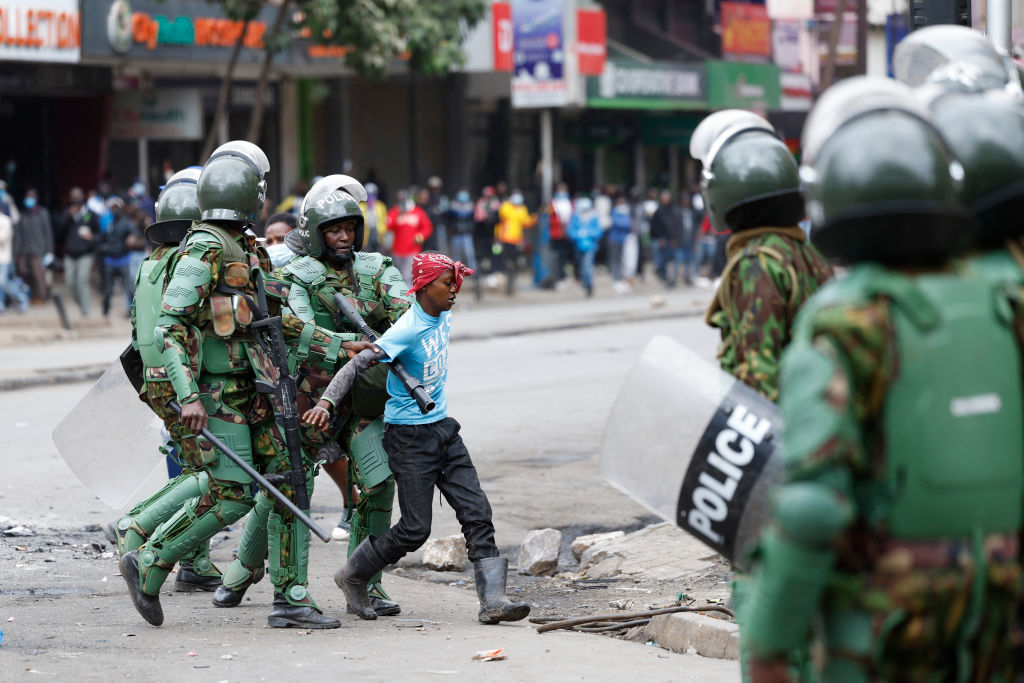Kenya Protests: Are The Kenyan Police Helping Or Hurting?
Source: SIMON MAINA / Getty
Kenya’s police are being criticised for their violent response to protests over the past week against government proposals to raise US$2.7 billion in additional taxes.
Hundreds of thousands of people, across 35 of Kenya’s 37 counties, poured out onto the streets in opposition to the tax hikes. The police have reacted with force, using live bullets and tear gas. At least five people are known to have been killed and hundreds have been injured.
The reaction by the police force didn’t come as a surprise. Kenya has a long history of policing with excessive force, often resulting in unnecessary deaths. And this time round, Kenyans were prepared. Posters outlining codes of conduct show guidelines on how to deal with harassment, teargas and medical emergencies.
We’ve published several articles that put these recent events into context.
Governance analyst Douglas Lucas Kivoi explains that the brutality exhibited by Kenya’s police force is a result of a number of factors. These include its beginnings under British colonial rule (the police weren’t there to serve the interests of the people, they were there to support the administration), poor recruitment policies, corruption and a lack of accountability for their actions – police will continue to operate with violence because they know they will get away with it.
Given this history, Kenyans don’t trust the police. Conflict researchers Kristine Höglund and Emma Elfversson explain that witnessing or experiencing unfair treatment undermines trust in Kenya’s police.
They write that the levels of mistrust are higher in urban settings than rural because police-citizen interactions are more frequent and visible and because of extrajudicial killings. Low levels of trust in a police force influence police effectiveness and public perceptions of safety.
Criminologist Kamau Wairuri provides deeper insights into the way this distrust manifests. Instead of turning to the police for help, Kenyans often rely on private security. In poor neighbourhoods, people sometimes turn to community vigilantism – they take security matters into their own hands.
The turn to vigilantism means that the police can’t bring perpetrators of crimes to justice. Wairuri explains that the police blame the community for not providing them with information that would help them catch criminals. And many criminal cases in Kenya fail because of police failure to provide adequate evidence in court.
Of course, not all citizen experiences of the police are about violence. There’s corruption and bribery, too. Citizens complain about how the police treat them like ATMs – a source of cash.
One place where citizens are most vulnerable are traffic police checkpoints, which liberally dot Kenya’s highways – but they’re not just about keeping road users safe. Governance specialist Gedion Onyango describes the “art of bribery” that has been created by corrupt traffic officers. Collected bribes move along the hierarchy to high-ranking beneficiaries at police headquarters.
Reform or abolish?
The government is aware of these issues and has been trying to build a more legitimate and effective police force.
Extensive attempts to reform the police began in earnest in 2008 when the police were found to be complicit in post-election violence. Reforms were codified into the 2010 constitution and new police legislation in 2011. These processes established national policies for community policing and an independent agency to improve civilian oversight.
But the reforms have largely failed. Policing expert Tessa Diphoorn reveals that police abuse has shown a “significant increase” over the past six years, rather than a decline. The Kenyan police remain repressive and unaccountable.
Why are the reforms not working? Through her research, Diphoorn found that various forms of misconduct were normalised as a part of everyday police work. Also, many officers were too scared to speak out against their colleagues. It could result in the denial of promotions or punishment – like being transferred to a hardship area. She also found that police officers sometimes covered for each other when involved in crime.
Having conducted hundreds of interviews and various studies, anthropologists Wangui Kimari and Zoltán Glück argue that the police should be abolished altogether. They found that Kenya’s police made Nairobi residents feel less safe and that the public didn’t depend on the police for safety.
It’s hard to imagine society without a police force. So what exactly would the abolition of the police force look like? Kimari and Glück explain that “police abolition” would mean dismantling ineffective and repressive institutions, replacing them with systems of actual safety.
Moina Spooner, Assistant Editor, The Conversation
This article is republished from The Conversation under a Creative Commons license. Read the original article.
SEE ALSO:
Kenya Protests: Obama’s Sister Praised For Bravery After She, Daughter Get Teargassed On Live TV
Campus Protests: Why Media Coverage Is More Drama Than Substance
The post Kenya Protests: Are The Kenyan Police Helping Or Hurting? appeared first on NewsOne.

